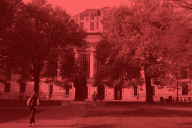You have /5 articles left.
Sign up for a free account or log in.
President Obama’s free community college proposal and college ratings initiatives promise to further the historic expansion of college access begun in 1965, when Congress created the Pell Grant Program, which pried open the doors of higher education to deserving but poor students.
But the administration’s chosen means to the praiseworthy end of further expanding college access do not fundamentally challenge inequality in higher education; instead, they reinforce our two-tiered and unequal system. Federal policy instead should encourage academically qualified, lower-income students to matriculate to selective, four-year colleges. A monetary rewards system (a Race to the Top for higher education) or statutory mandates could advance that objective.
The current proposals are inadequate means to the laudable end of increasing access for the disadvantaged for three main reasons. First, money is not enough to ensure the success of low-income and first-generation college students (an often overlooked group that it is good to see included in the administration’s proposals). A shortage of financial resources is an important part -- but just one dimension -- of the multifaceted challenges that hinder lower-income and first-generation students. These students not only face financial impediments, but also confront social and cultural challenges in higher education. They lack the parental support, social networks and human capital of wealthier students with college-educated parents. Students without family and social connections to the world of higher education often find it difficult to navigate collegiate life.
The majority of such students matriculate to two-year colleges. These campuses are literally and figuratively closer to home. At more selective institutions, the gulf between college and community life is greatest and the commitment to educating Pell Grant-eligible, first-generation students is less robust, judging from enrollment statistics. (Studies show that the most competitive colleges are the least likely to enroll Pell Grant students).
In effect, there are two vastly different systems of education: one for richer students from college-educated parents and another for poorer students from undereducated families.
But most community colleges are not equipped to provide the academic and social supports necessary for the success of the capable but needy students drawn to them -- the second flaw in the administration’s means to a worthy end. Reams of data have long documented the struggle of community colleges to deliver the quality education and additional support that students need. Teaching staffs at these colleges juggle heavy course loads and are responsible for hundreds of students, many of whom need remedial instruction in basic skills. Graduation rates at community colleges are meager. And, although many students enter community college with plans to transfer to four-year institutions, only one in five actually does.
In effect, there are two vastly different systems of education: one for richer students from college-educated parents and another for poorer students from undereducated families. Richer students overwhelmingly attend the nation’s selective colleges and universities, where admissions officials have their pick of applicants.
Poorer, first-generation students overwhelmingly attend community colleges. Even some poorer students who are academically qualified for far more competitive institutions choose community colleges -- a phenomenon called “undermatching.”
The administration’s proposals will not end these inequities and do not aspire to end them. The community college proposal is instead a concession to the inevitability of a two-tiered, separate and unequal, system and will reinforce the status quo, including undermatching.
To be clear, there certainly is a role for a strong community college system in the educational marketplace. For some students, two-year colleges are an appropriate choice. And the federal government should strengthen these institutions by increasing funding to them across the board. But it can reform the community college system without also enacting policies that funnel academically able, poorer students into two-year rather than four-year colleges. In other words, the federal government could increase allocations to community colleges and also promote greater access for lower-income students. It need not tether the latter policy objective to the former.
Given the well-known limitations of two-year colleges, my recent proposal to increase college access for Pell Grant-eligible, first-generation students promoted greater outreach by selective, four-year institutions of higher education. Selective is not synonymous with Ivy League; it includes the most competitive private colleges, cash-starved state-supported universities and lesser-known liberal arts colleges that specialize in a student-centered educational experience.
The best selective institutions invest in the success of all admitted students. These colleges award generous financial aid packages and provide institutional support ranging from dedicated personnel to enrichment classes and social clubs to acculturate students to college life and facilitate academic progress. These are the colleges that produce the greatest return on investment and can change the life trajectories of students from disadvantaged backgrounds. Federal policy should encourage academically qualified, lower-income students to matriculate to selective colleges through monetary rewards or statutory mandates (as I will explain below).
The third challenge in the administration’s proposals pertains to its rating system, which is neither a necessary nor sufficient means to the government’s ends. Ratings alone are unlikely to substantially increase college access for Pell Grant-eligible, first-generation students. Identifying the colleges that are the least successful at providing access is an important initial step, one that I have advocated. The proposed ratings will help diagnose the nature of the access problem for economically and educationally disadvantaged students. However, different incentives are necessary to spur corrective action.
The federal government can incentivize access for lower-income students at selective institutions in one of two ways. One type of incentive would work by conferring a reward on the institution for increasing access for the disadvantaged. The federal government could create a system of competitive grants and award additional federal dollars to colleges that enroll and provide effective support programs to a minimum percentage of Pell Grant-eligible and first-generation students. In other words, it could launch for higher education an analogue to the Race to the Top program established in 2009 to spur innovation in K-12 education.
The Obama administration reportedly plans to connect high ratings in its new system to additional federal funding. But judging from the tremendous pushback against the ratings system, its future is doubtful. And it is unnecessary to effect change. The government can promise more money to colleges that enroll a minimum number of low-income students without implementing a ratings plan.
A different kind of incentive program might work by imposing a penalty for noncompliance. Just as the nation once mandated race- and sex-based integration of colleges and universities, Congress and the Department of Education can compel the economic integration of America’s college campuses. The government could mandate, for example, that colleges receiving Higher Education Act funds admit and fund a minimum percentage of low-income, first-generation students or risk losing federal funds.
This kind of mandate would function like Title VI of the Civil Rights Act or Title IX of the Education Amendments of 1972, which require federally assisted programs to meet certain nondiscrimination requirements. Statutory mandates not only have been used to integrate colleges and secondary schools, but to increase the number of girls and women who participate in competitive sports programs, and, most recently, to mandate compliance with new substantive legal standards on campus sexual harassment and sexual assault.
Greater college access for qualified but needy students also could be achieved through federal statutory mandates. Whether this approach can serve as a viable avenue to reform is no doubt uncertain, however, given Congressional gridlock and ideological resistance to federal mandates.
Whatever else it does, the government should promote true equality of opportunity in higher education. It should neither prop up our two-tier system nor view the problem of unequal access to college as primarily a money problem. A reward or mandate system should be implemented to encourage federally assisted colleges -- especially cash-starved, selective, four-year public universities -- to educate greater numbers of qualified, disadvantaged students. Federal policy should not reinforce class stratification in higher education.








